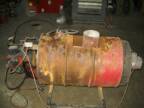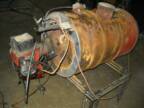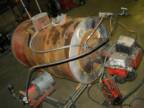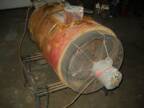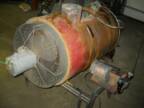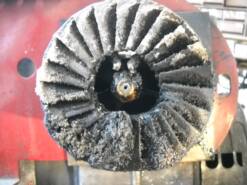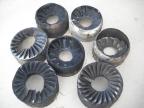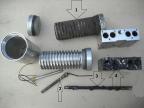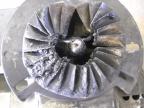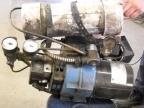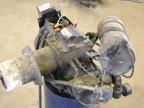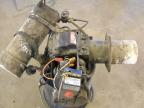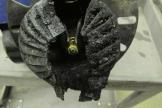Technical Help
Flame Problems
This technical help is only intended for customers of Central Ohio Heaters, Ltd., whose furnaces have passed our 50-point safety inspection. If you bought your heater from someone else, ask them what is wrong with your heater.
If your furnace has not passed our 50-point safety inspection, please do not use our technical help page, as your furnace may be dangerous; clean ash out of your heater before proceeding.
Warning! Use this Technical Help only at your own risk. We are not responsible for things beyond our control. This page is just a kind gesture from Central Ohio Heaters, Ltd.
Normal Flame Adjustment consists of 4 things. These all need to work together.
A. Oil Volume and Pressure (preset on Meter Pump models; other models need checked at least
weekly.)
B. Atomization air Pressure (preset on select models).
C. Combustion Air Adjustment (This is adjustable on all models.)
D. Draft (Without proper draft, it is impossible to get a good flame.)
#1 Flame Appearance
Flame should be a bright white-yellow color, all the way through. Entire flame is the same color under normal conditions, but the last 3" is the first to change color when it needs adjusting.
A. A dark tail on the flame is the beginning of black smoke. This is caused by too much oil making a fuel-rich flame.
B. If air pressure is too low, you will likely have lots of fireflies coming out of the flame, or you could have a black color on the tail of the flame. This is because of poor atomization.
C. If the air pressure or combustion air is a little too high, the flame may begin to flash, flicker, flutter, or get slightly brown.
D. If the flame is very brown, it is very lean; probably too much air pressure or combustion air. This lean condition will melt your stainless target in half. Your retention head has a lot to do with the flame appearance. Check to see if it is crusted over or bent. If you don't get a good flame, you may need an updated retention head. See our parts page, as this is very important. If it is burning properly, the ash should be tan or maybe white inside the furnace, after burning for a while.
#2 Flame Size Fluctuation
A. This can be due to suction leaks on your oil pumping system. This normally causes the gauges to bounce, and the flame will spit and sputter continuously, when air bubbles are coming through the oil pumping system.
B. Pump shaft seal could be defective and sucking air; if so, you will need to replace your pump. You should also check your filter and fittings to see if they are sucking air. See our parts page.
C. This could also be due to varying viscosities of fuel. Your best option is to update to a meter pump. This is a volume-control pump, and does not use a pressure regulator at all. This pump is RPM-specific, for each different size furnace, making the correct volume at the pump, hence the right size flame in your furnace. You must call us at 330-674-0142 to get the correct pump and RPM-specific motor for your furnace. People love these pumps, because they work super, and no flame adjustment is ever necessary. Even when using thick, thin, hot, or cold fuel, the flame size will not fluctuate. These pumps will also build up pressure (up to 50 PSI) behind a clogged nozzle, blowing the build up right through. You furnace will slightly cough, spit, sputter, and keep right on trucking, even at 2 AM.
#3 Black Smoke? (This is improper fuel adjustment (fuel-rich flame)).
A. Decrease fuel pressure / adjust combustion air / adjust atomization air pressure.
B. Flame Length should be approximately 3/4 of the way across the chamber (except models with long chamber).
C. Other Problems? Oil spilt, leaked, or pumped in the chamber. Do not fire, until the mess is cleaned up, because this will make lots of black smoke or even rumble, as the oil burns off of the floor of chamber.
D. Other Possibilities: holes in tubes (This will cause back-draft when fan or blower comes on.), defective, cracked, warped, or plugged chamber / plugged exhaust system / plugged rain cap outside.
#4 Burner attempts to run, but won't establish a flame? (Even though there is oil and air pressure, combustion air, and spark, here are some possible causes.)
A. Combustion air band open too far.
B. Atomization air pressure too high. Typically 15 PSI or less on most models.
C. Oil temperature too cold. (Aluminum block should be 140° - 160°. All models need at least 15 minutes of warm up time.) See 7C below.
D. Defective or wrong size nozzle. (Poor vortex pattern at nozzle and retention head, especially if you can drop the air pressure, and it lights right away. You might check the distance that the flame burns in front of the retention head with a mirror, when the flame is running. If it runs more than 1 1/2" away, you may have poor vortex in front of the retention head. Call us for a quality tune-up.) Also see 4J below.
E. Defective or carbonized retention head.
F. Worn or improper electrode adjustments, or carbonized clinker on electrode tip. (This results from poor draft.)
G. Improper protrusion of nozzle through retention head. (1/8" front on most models. Reznor 0-1/8”.)
H. Cabinet plugged up with ash. (This can cause delayed ignition.)
I. Burner combustion air blower fan not running at all.
J. Plugged nozzle. This will result in high oil pressure (with meter pump), or a short flame (without meter pump). Remove nozzle and blow compressed air through the nozzle both ways several times, to remove any carbon or fuzzy pieces etc. If you have the nozzle clean, you will be able to see straight through it. If you can't see through the nozzle, it is NOT clean. After cleaning, oil O-ring, and reassemble. Lanair: Install quad-ring in block first, or quad-ring will get cut. Read your manual. If this happens repeatedly, there are additional problems. See #11 below.
K. Defective oil or air solenoid, not letting the oil or air whistle through the nozzle, and into chamber. (Look for an oil mist, when burner is trying to fire.) Sometimes the air solenoid plunger gets rusted up from moisture in the air line over summer and needs disassembled and cleaned, to get it free so it can work properly. Shenandoah won't start at all. Clean Burn, Kagi, and Lanair will not allow air to whistle through the nozzle, thus shutting down the oil flow/pump, and no flame. On Lanair, check to make sure electromagnet is working. Sometimes it gets a bad connection at the electromagnet wiring terminal and no magnetism is present, therefore the solenoid never opens, sometimes resulting in high oil pressure at burner gauge, or no oil mist in chamber.
L. Transformer, has current, but is too weak. When burner is trying to fire, some people short the power lugs (with an insulated, uncracked screwdriver), wearing dry leather gloves, and stretch the spark from lug to screwdriver. They say it should be able to stretch from 3/4" - 1", and have a fuzzy appearance when it is stretched out. Do not try what some of these people have tried, because it is 14,000 volts of electric, and will knock you off the ladder. Refer to a professional, who has proper testing equipment. Only experienced professionals should do this; others may get shocked and fall off the ladder.
M. Cracked electrode insulators may let the high voltage leak, and ground out on the case. This will prevent the electric from ever getting to the tip of the electrodes. Also look for arcing below transformer power lugs on aluminum block. Sometimes the tabs ground out on the case.
N. Electrical ignition problems. The easiest way to rule this out, is to wrap a paper towel around a long rod, light it, and shove it in front of the gun (inside the cabinet), then have someone turn the burner on. If it lights and burns fine for 30 minutes, or more, but won't relight, the problem is in the electrodes or the transformer. Only experienced professionals should do this; others might fall off the ladder if they burn their finger or if the fire momentarily bursts out the peep-hole. Adjust electrodes approximately 1/16" ‑ 1/8" in front of the nozzle (1/8" between electrodes at closest point), and 3/8" above center line of nozzle. The easiest way to check this is to use a standard 5/8" spark plug socket. Put it on the tip of the nozzle, and it should raise the electrodes ever so slightly (on most models-check your book to be sure). Spark should be between electrodes, and not leap to nozzle or flame cone. If it does, high voltage arcing will destroy the nozzle, and make a crooked flame. (Spark should be blown front by combustion air when running-use mirror to check when burning.)
O. Water or antifreeze may be in the tank, and is now being pumped up to the burner. Drain and flush tank, filters, pump, and lines. Then retry.
P. Pump (on the tank) not running. (It must run whenever the burner tries to fire & stop when burner stops.)
Q. Your quad-ring (Lanair) behind the nozzle, or nozzle O-ring (most other brands), or brass nozzle adapter (Shenandoah only) could be bad. To check for this, momentarily drop air pressure and see if it lights better then; if so, change these O-rings. (They may be cut or smashed.) Or, disassemble to check.
R. It is also possible for the oil to be too dead to light, or the flash point could be too high. (Such as brand new oil, which has too many flame retardants in it which would normally wear down with time, or too much synthetic oil or 90-weight mixed in.) Some people just mix fuel oil in, to lower the flash point of their oil. DON'T EVEN THINK OF EVER USING GAS!! Doing so would turn your tank into a bomb, if a spark would ever enter your tank. Only burn listed fuels: see your instructions manual.
S. Most brands: Sometimes the temperature switch is set too low; just raise the temperature if needed. Normal adjustable temperature settings on most burners is 140°. Try temporarily raising it 20° or more. Let it warm up for 10 minutes; if it works fine, great, but don't let it set at 170° all the time, as this will cook the oil in the heater block. On some models the temperature switch is not adjustable, such as Shenandoah. Their old switches sometimes turn on at too low of a temperature. Therefore it will not light properly on the lower swing of the temperature on and off setting. If it lights fine on the upper swing, but not on the lower swing, the temperature control is probably defective. Just watch to see when the red light comes on. Also some other brands (Reznor, Lanair, Black Gold, and Omni) have non-adjustable switches. The easiest way to tell if these are warm enough is to quickly touch the heater block with your finger, but be fast (some aluminum heater blocks (Lanair and Reznor) run up to 180°) . At 180°, most people cannot hold their finger on the heater block more than 1 second. At 140°, most people can hold their finger on the heater block approximately 5 seconds (Shenandoah, Clean Burn, and Omni). If the heater block is stone cold, you found the problem. It won't light when it is cold. Still have problems that you can't fix? Call us at Central Ohio Heaters, Ltd. 330-674-0142. We have parts in stock for all major brands of furnaces, and some parts for obsolete furnaces.
#5 Burner attempts to run, but won't establish a flame? (Even though there may be no oil pressure, no air pressure, or very high oil pressure at burner, here are some possible causes.)
A. Defective or rusted oil or air solenoid, not letting the oil or air through the nozzle, and into chamber (sometimes air solenoids get rusted up during the summer). (Look for an oil mist, when burner is trying to fire.) Lanair: Running air pressure too low when trying to fire therefore oil valve never opens. Try raising running air PSI somewhere around 15 PSI. Also check to make sure electromagnet is working. Sometimes it gets a bad connection at the electromagnet wiring terminal and no magnetism is present, therefore the solenoid never opens, sometimes resulting in high oil pressure at burner gauge, or no oil mist in chamber. Clean Burn & Kagi: Too low air pressure does not close air prove switch, therefore no pump action on tank, and therefore no flame. Usually requires minimum air pressure to be 15 PSI (running). Reznor: Burner tries to fire, but no oil mist is being sprayed into chamber. Bad compressor? To check air pressure, remove the Reznor ⅛” NPT bleed off bleeder (at air compressor 4 way tee), and install a 3-way tee, a 20-40 PSI gauge, and the Reznor bleed-off bleeder together, to test the air pressure in-line when trying to fire. The in-line gauge should then read minimum 9-12 PSI when burner tries to fire. If not, then the compressor is defective. It will not close the low air switch to engage oil solenoid, thus no flame. Black Gold is similar to Reznor: If compressor has low or no output PSI, there will be low or no atomization, hence no flame. You can remove ¼” NPT plug in the back of the compressor and check for minimum 9 PSI (compressor output pressure) when burner is trying to fire, using a 20-40 PSI gauge. Note: On models with an adjustable air pressure, do not go over 15-20 PSI without calling us (at 330-674-0142), or you may melt the target. Other brands: are similar: low or no compressed air means no flame or mist.
B. No combustion air (burner combustion air blower motor not running).
C. Dirty nozzle. If you have over 30 PSI on burner oil gauge (any brand with meter pump) while burner is trying to fire—either nozzle, pre-heater block, or solenoid is clogged or not opening-see 5D below or 4J above.
D. Check for magnetic pulse at oil solenoid electromagnetic. To check it, remove the electromagnet and put a steel screwdriver inside & turn burner on. It will make a magnetic frequency/pulse/hum in screwdriver handle from the electromagnetism if not it's not working.
#6 Burner can fire repeatedly, but won't stay on. (Red button trips on flame controller.)
1. Your suction filter system could be clogged. If the suction system is clogged, the flame will get shorter & dimmer while the pump pulls a hard vacuum (7"-25" or more). Have someone check the oil pumping system vacuum gauge after the heater has been running for 5-20 minutes. If the flame goes out, the red safety button will pop up and need reset. Replace/clean the suction filter, bleed, and retry. Also see #7 and 12F below.
2. If the flame burns nice until the red button trips, the electric eye could be dirty. Remove and clean it. If is still doesn't run longer than 30 – 45 seconds, the electric eye or flame controller (oil primary) could be defective. To check the ohms on the electric eye, disconnect cad-cell wires from oil primary (flame controller), and measure resistance (ohms) on the two, bare, yellow, wire ends when flame is burning. It must be under 1,500 ohms, or it will trip the reset button. With a good flame, you should typically get under 900 ohms. If it is under 900 ohms, and the button still pops, the flame controller is probably defective. Do not bypass safety control's F&F terminals. They are designed to stop burner in the event of a flame out for your protection. See our parts page to order one, or call us. (Note: non-electronic flame controllers need 4 minutes to cool down internally between resets; be patient!!!!!)
#7 Burner fires, but flame soon disappears, then tries for 30-45 seconds with no flame, then the reset button pops on the flame controller (oil primary), causing the burner to shut down (will not re-fire repeatedly).
A. Oil system not properly bled (air or water in the oil line). There should be a steady oil flow up to the burner. Bleed off two quarts of oil, from the oil supply line going to the burner. Then retry.
B. Plugged or partially plugged or damaged nozzle. You will normally need lots of pressure if your nozzle is plugged, or the flame will be very small. Remove nozzle, blow it out with compressed air several times both ways until you can see through the nozzle (otherwise, it is not clean). Then oil the O-ring, and reassemble. (Lanair: be sure quad-ring is in the block and not on the nozzle. See Lanair book.)
C. Oil preheater block temperature could be too low, or bottom preheater could be burnt out (oil inlet fitting will not be hot after burner starts firing a while). A Lanair burner in this condition will normally start fine, but as the block cools down, the flame will get lousy with lots of fireflies, then the flame will walk away from the gun. If you wait 15-30 minutes, it will restart fine, but soon go out again. The normal block temperature on most models is 140° - 160°. Also see 4S above.
D. Shenandoah: Shop air pressure coming to the burner must not have air pressure regulator in the line (minimum 80 PSI). Low air pressure will shut the burner down. Your 300-watt air heater element in slide-out heater block may be burned out, causing a low block temperature after a couple minutes of run time (especially in a cold shop), thus lots of fireflies in flame, then a loss of flame. Check this 300-watt heater element (with an inductive amp meter); it should pull 2 3/4 amps when the flame first fires. But, keep in mind that if the block temperature goes over 160°, the upper thermostat will open the circuit and it will not pull any amperage till the block cools back down. This circuit only pulls amperage when the flame is running.
E. Clean Burn, Lanair, and Kagi burners etc. must have sufficient air pressure on the air gauge (typically approximately 15 PSI), or burner will shut down. Low air pressure at nozzle may be accompanied by fireflies in the flame. Lanair: Also check amperage on both heater elements; if one is burned out, it will not heat properly. (Both elements together should pull about 4.5 amps when they are heating. Check these two elements with an inductive amp meter.) Or, hold onto inlet oil fitting; if it soon gets cold, (about the same time the flame goes out), you probably have your lower heating element burned out. See Tech's tip below.
F. Carbonization baked onto the retention head may make a poor flame.
G. Cabinet majorly plugged up with ash and exhaust can't get out of it (therefore flame gets smothered).
H. No combustion air (burner combustion air blower motor not running).
I. Tech's tip: Use a hair dryer (hot air gun) to blow hot air into the burner combustion air suction, to see if this helps it run better. If so, you are dealing with a low temperature problem.
#8 Burner runs great all day, but needs reset most mornings, or after long idle periods.
Shenandoah, Clean Burn, Lanair, Kagi, and Others: Turning your air compressor off at night will shut down your burner, due to low air pressure, and trip the red reset button during the night.
A. Copper line flare fitting too loose, or meter pump 90° fitting is loose at the filter. (These fittings are shipped loose, and must be tightened at correct angle by customer.) These must be good and tight; use black aviation Permatex.
B. Customers sometimes throw flair fitting away and use compression fitting on suction side. (They normally make their own problems by doing this.)
C. Suction line has poor or cracked flair on it at top end of copper line where it meets brass 90° flair fitting. Inspect it carefully for imperfections or cracks; they are not acceptable at all. These will suck air in.
D. Does your heater cycle properly all day, but requires being reset each morning or after a long idle period? It is very likely a leak in the suction line, suction filter, suction gauge, or pump shaft seal, or the pump cover gasket. (If you ever remove the 7710 pump cover, you must also replace the cork gasket.) Pump must be able to pump oil out of bleeder for 15 minutes straight, without seeing any air bubbles. If you still see air bubbles, it has to be getting in on the suction side, and it is usually a cracked or bad flair on the copper suction line. Check this connection first!!!! We know. Use black Permatex on all suction fittings. Tighten flair copper line nut good and snug.
E. If the oil line goes up to the ceiling and back down to the heater, you will make lots of problems with nuisance shutdowns and no-fire conditions. You must go uphill all the way, or call us for any other options (330-674-0142).
F. Also see #12 D below.
#9 Green limit status light goes off during operation. Flame goes out at the same time.
This is likely an over-heat condition. Overheating your furnace will shut down the power to the flame controller. DO NOT BYPASS: find the cause; it is for your safety. We recommend calling a professional to get it right.
#10 No action on burner motor or burner head at all? This is likely an electrical problem. (All waste oil furnaces need the circuit breaker turned on for at least 15 minutes, to warm the heater block. Some units have shut-downs.)
Reznor: 1 of the 5 limits is probably open, hence no green limit status light near flame controller (oil primary) (see flow chart in Reznor book) or wait 10 minutes.
Shenandoah: Your burner motor might not be spinning, or centrifugal switch might be defective, or the air pressure might be too low. (No air pressure regulators are allowed between air compressor and burner inlet--80 PSI minimum.)
Clean Burn: Check to see if over-heat switch is tripped inside air outlet elbow (red wire). (Models 2500, 3500, and 5000 only)
All models: You must wait minimum 15 minutes (30 minutes for Black Gold) for burner to warm up, before it will fire. Some burners have an automatic shut-down, which will prevent any action until it is warmed up. Still have problems that you can't fix? Call us at Central Ohio Heaters, Ltd. 330-674-0142. We have parts in stock for all major brands of furnaces, and some parts for obsolete furnaces.
#11 Nozzle clogs repeatedly? Tech's tip: Turn power off going to heater in summer.
A. Safety suction screen may be broken inside pump on tank (any brand or model using a pump on tank).
B. Clean Burn HS and Kagi Burner: 50-watt oil pre-heater may be carbonized. (This can happen repeatedly, and be very frustrating.) Your burner's heater block may need to be flushed and cleaned inside: we offer this service, as well as completely rebuilt, exchanged burner heads. See our parts page.
C. Clean Burn 500 Burner, and Clean Burn 100 (Saturn) Burner: Nozzle preheater assembly may be carbonized inside. Also, main aluminum heater block may be carbonized inside. We offer completely rebuilt, exchange burner heads. See our parts page. Also see bottom of this page.
D. Shenandoah Burner: aluminum heater block may be carbonized inside. We offer completely rebuilt, exchange burner heads and slide-out heater blocks. See our Shenandoah parts page.
E. Reznor Burner: aluminum pre-heater block below burner may be carbonized inside. Then this will also plug up screen at oil solenoid on left side of burner, at copper line. Burner pre-heater must be disassembled to clean this. We offer completely rebuilt, exchanged burner heads. See our Reznor parts page.
F. Lanair Burner HI, FI, and MX series oil pre-heater assembly may be carbonized inside. This will repeatedly knock off pieces of carbon, and plug nozzle soon after the flame starts. We can ship new, complete, pre-heater assembly (drop in module) ($295 exchanged, includes retention head, nozzle, O-rings, 2 blocks, 2 pre-heaters, and diaphragm complete). See our Lanair parts page. Also see bottom of this page.
G. Black Gold / Energy Logic Burners Pre-heater is probably carbonized internally, between fins. Disassemble and clean, or we offer completely rebuilt, exchange burner heads and smart pre- heaters. See our Black Gold parts page. Also see bottom of this page for pix of dirty oil pre-heater parts.
#12 Oil Pumping System
A. Initial priming: Fill spin-on filter with clean used motor oil before priming meter pump, so that it will prime 10 times faster. If you prime with new (unused) motor oil, it probably won't fire, because of the flame-proof agents contained in new oil.
B. Does your heater cycle properly all day, but requires being reset each morning or after a long idle period? It is very likely a leak in the supply line / suction filter / pump shaft seal (A2RA-7710 pump) is sucking air. Pump must be able to pump oil out of bleeder for 15 minutes straight, without seeing any air bubbles. Also see #8 above.
C. Does your pump work fine when pumping used oil, but won't pump thin fuel? If so, your internal pump gears are worn out, and the pump head needs to be replaced. See our parts page.
D. Fuel line must go uphill all the way to burner or air will not bleed out properly. Then if nozzle gets plugged, it will need to squish the air pocket in the line, before it can build up 50 PSI behind the nozzle to push the carbon out Before this can happen, burner will lockout (on safety) because of no flame and your shop will be cold in the morning. (This is caused by an installation error. Call us at: 330-674-0142.)
E. Checking for Suction Leaks in Meter Pump System
If your tank has plenty of oil in it, but you continue to get air bubbles at burner bleeder tee #9, (page 2, figure #7 in meter pump manual), there could be a suction leak at one of several places such as: pump shaft seal, filter head cracked or damaged, flare fitting loose or cracked at copper flare, damaged flare fitting, Lenz filter loose, no Permatex on pipe fittings or suction gauge, kinked line, bleeder on 7710 pump loose, or a crack in the pump housing (Someone may have removed pump cover and did not install new gasket when replacing the cover, or, (Allen head) bolts on pump cover could be loose.), etc. To check the pumping system for sure, prime or run pump for 15 minutes to get a decent flow. Then stop pump and cap off part #18, (page 2, figure #8) (after cleaning and inspecting for damage), with a brass female ½” flare cap (page 4, figure #26, part #37). Tighten it securely and run only the pump (burner not running). Pressure should build up at gauge on burner tee #9, (page 2, figure #7) and continue pumping until vacuum gauge (page 2, figure #8, part #16) goes down to 15” vacuum. Then turn pump off. If your pumping system is okay, it should hold the vacuum for at least fifteen minutes. If so, your problem is in the suction line. If the vacuum rises toward 0” on the vacuum gauge, there is a suction leak in the pumping system itself. Inspect all parts carefully. Check for worn shaft (sideways movement) etc. See meter pump book or call for help.
F. Plugged Filters Replace/clean the filters. Bleed and retry. Read below.
Do not run your heater when you are filling your tank, as this will stir up the mud in the bottom of your tank, and bring dirty oil into your filter. Do not rush-fill your oil supply tank, as this stirs up the mud. Also, keep suction line 10" up off the floor of your tank. This keeps the sludge / water out of your filters and pump system. It also slows down the churning effect, if there is 10" of oil in the bottom of your tank, before you start filling it. Also put the pump on one end of your tank, and your fill on the opposite end of the tank, or use the double-tanking system. (The double-tanking system is the preferred method. Ask us for a print-out to set up your oil tank system properly. This works great.)
#13 Poor Draft or Back-Draft
A. Is heat exiting at the peep door, when you open it for flame inspection? If so, there is a back-draft, caused by a plugged heat-exchanger, elbows, stack pipes, or outside rain cap etc. Clean ash out regularly (250 - 500 hours, depending on your furnace).
B. As a possible condition of back-draft, check for a large exhaust fan in your building, pushing air out of building. This leaves the building in a big vacuum, and causes back-draft in the furnace, pulling the exhaust back down the chimney. Your building needs to be properly vented!!!
C. Back-draft or poor draft will cause carbonization, crusting over, or gunk on the retention head. This is normally a poor draft issue.
D. Do yourself a favor, and check your flame and draft weekly, and clean the ash out of your furnace, in a timely manner. If you don't, the heat will be unable to get out of your furnace, and you will need to call us for a new furnace!! (Trust us. We have seen it all!) Your fire chamber will get too hot, and can even melt a hole through the side, if it is plugged up.
#14 Poor Quality Flame (barely burns)
A. Dirty Nozzle? Remove and blow backwards with compressed air. Make sure you can see through the nozzle, or it is not clean.
B. Dirty/bad retention head? Burn grease off. See bottom of technical help page on website.
C. Poor draft? Clean ash out of heater/chimney, or use taller stack.
D. Flutter---combustion air adjustment or defective nozzle/nozzle adapter or o-rings behind nozzle adapter (maybe flat, hard, or cut)
E. No combustion air (blower not running at all)
F. Cold preheater? See 7C above.
G. Air PSI too low
This technical help is only intended for customers of Central Ohio Heaters, Ltd., whose furnaces have passed our 50-point safety inspection. If you bought your heater from someone else, ask them what is wrong with your heater.
If your furnace has not passed our 50-point safety inspection, please do not use our technical help page, as your furnace may be dangerous; clean ash out of your heater before proceeding.
Warning! Use this Technical Help only at your own risk. We are not responsible for things beyond our control. This page is just a kind gesture from Central Ohio Heaters, Ltd.
Waste oil furnaces are our specialty; it is all we do. If you are experiencing problems or frustrations with your current waste oil heater, we can fix, update, and/or rebuild it, guaranteed!
Think: Do you have a troublesome heater? If your labor rate is $40 - $60/hour, you may soon pay for a reconditioned heater, just in the time you spend on your old heater!
Call us at 330-674-0142!! or click here to see our tech help videos page for more info
Be sure to clean your furnace out at regular intervals!
Click here to download a printer-friendly version.
Click here to download a printer-friendly technical help version.
Millersburg,
OH 44654
P:330-674-0142
Why Choose Us?
1. We make satisfied customers a priority.
2. We have the best value.
3. We do what we say we're going to do, within an agreed timeframe.
4. We have the parts in stock to get you up
and running.
This customer got lots of experience working on this old junker, just to get his shop warm when he should have been working on customer's vehicles (for $60 per hour). He is now a happy customer of Central Ohio Heaters, Ltd. He bought a reconditioned 280,000 BTU Clean Burn and has tons more heat with no headaches. He would not go back to this unsafe junker. Normally a reconditioned heater will pay for itself in 1 - 2 seasons. Save yourself the headache and trade up today!
Call us at: 330-674-0142.
Would you believe this? A waste oil heater with out maintenance will not burn clean. If your retention head gets clogged, just remove it. Then lay a piece of metal on top of a steel 5-gallon bucket full of water, lay retention head on metal, burn off most of grease / carbon carefully with torch, then tip retention head over into the cold water. The sizzling action will loosen the carbon super fast; repeat if needed. Or call us for new tune up parts.
warning !!! do not fill chamber with explosive vapors, hot oil fog, or anything similar or it may explode violently and shoot fire out the flame inspection port etc especially if unit is hot and struggles to light let unit cool down before proceeding!!
Warning! Use this Technical Help only at your own risk. We are not responsible for things beyond our control. This page is just a kind gesture from Central Ohio Heaters, Ltd.
Warning! Use this Technical Help only at your own risk. We are not responsible for things beyond our control. This page is just a kind gesture from Central Ohio Heaters, Ltd.
Warning!
Oil & anti-freeze soaked ash can burn furiously and uncontrollably inside your heater and may even come out the peep door. This may get your exhaust red-hot, or even burn through your old rusty stack system.
Clean ash out of your heater before proceeding!!!
Use this Technical Help only at your own risk. We are not responsible for things beyond our control. This page is just a kind gesture from Central Ohio Heaters, Ltd.
Ever wonder why it won't work very well: take a look below & call us for the parts you need. We have most in stock and can exchange units on credit card & ship ups.
dirty damaged retention heads,electrodes,nozzles and oil pre-heater parts .
these 2 heat chambers plugged up solid with ash in both above
what a complicated contraption, get name brand quality it can be so simple & really work well for years
our recon chamber
we recomend that you install a carbon monoxide detector on all 4 walls of your shop for your personal safety and to avoid carbon monoxide poisoning of your workers
we recomend that you ship burners in to us before sept 1st if you want a summer rebuild when weather is warm otherwise we have reconditioned burners in stock in cold weather season
If you use this technical help page you are agreeing to use it only at your own risk.
If you bought your heater from some one else ask them what your heater problem is.
see our tutorial videos on bottom of most pages
nozzles damaged by electrodes
why dont people clean ash out of chamber?
If you use this technical help page you are agreeing to use it only at your own risk.
If you bought your heater from some one else ask them what your heater problem is.
If you use this technical help page you are agreeing to use it only at your own risk.
If you bought your heater from some one else ask them what your heater problem is.
All trademarks are the property of their prospective owners / holders
